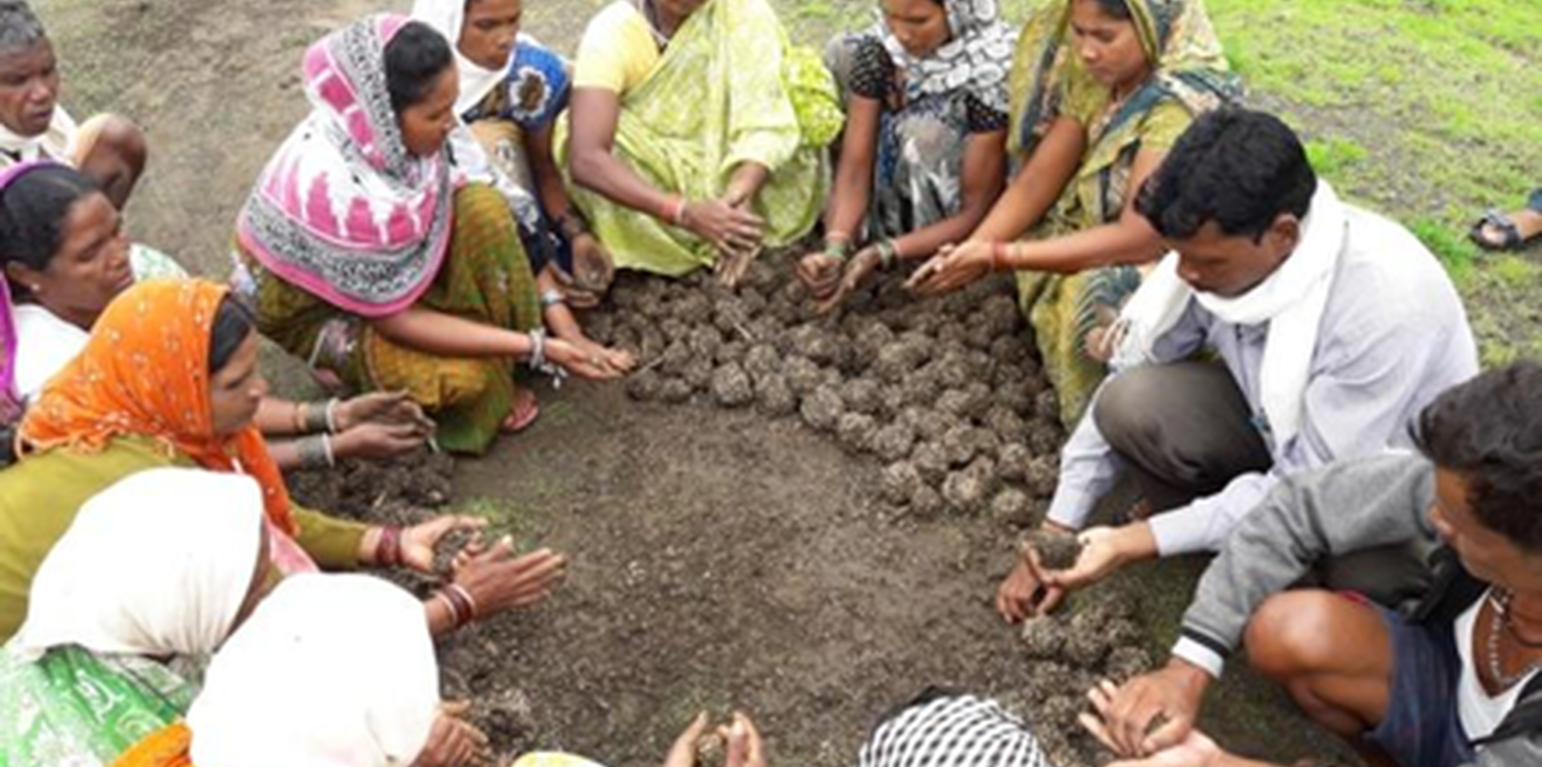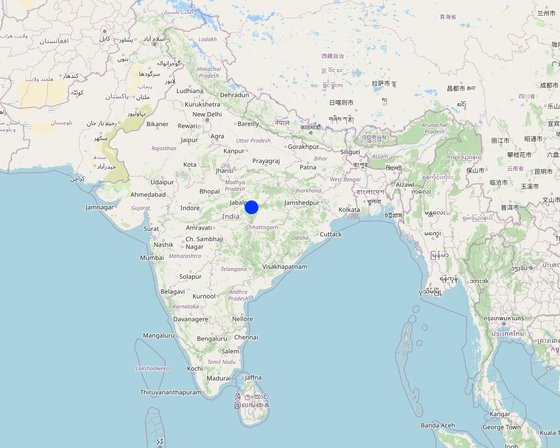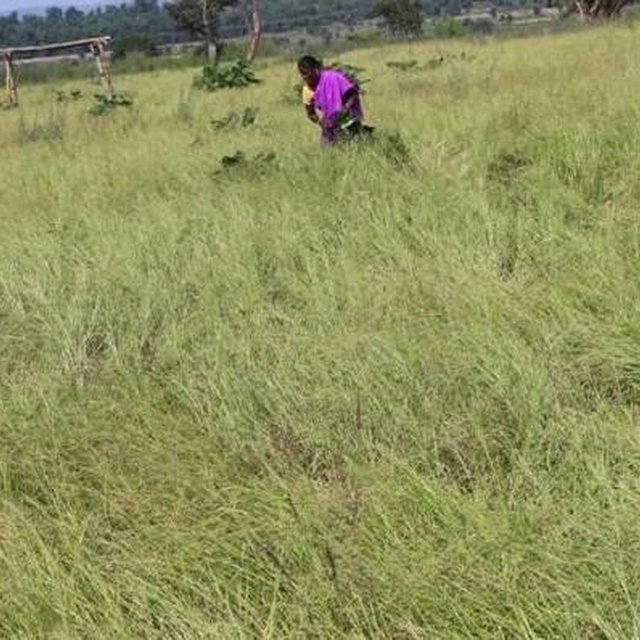



Community-based soil rehabilitation after the eradication of the invasive plant species, Lantana Camara, is an effective technique for restoring grasslands on common lands that had earlier been invaded by this species. The invasion of Lantana Camara can have significant negative impacts on the ecosystem, reducing the diversity of plant life and disrupting the local communities' use of common lands for grazing, for agriculture, and for collecting non-timber forest products.
To address these issues, a three-tier institutional structure is being used by the project-implementing organization Foundation for Ecological Security (FES). This structure includes the formation of informal women groups at the hamlet level, the Village Environment Committee (VEC) at the village level, and an executive committee at the cluster level. The VEC prepares proposals on common issues and plans with budgets that are presented to the executive committee, which is made up of a mix of individuals, with 50% of the seats reserved for women.
The first step in the process is for the village executive committee to take the Gram Sabha (Village Governing Body) into confidence and prepare bylaws for the restoration and conservation of the Lantana-eradicated site. These bylaws are regularly discussed in the village institution meeting to refresh the memory of the community and different stakeholders on how to properly conserve the site. Local resource persons facilitate the implementation of work.
One of the major works undertaken by these communities in the Mandla District is the soil rehabilitation from Lantana Camara for grassland restoration on common lands. The uprooting of Lantana is a tricky process, and improper methods can result in an even more forceful recurrence of the species. Therefore, the "cut rootstock" method is used, which involves cutting the root of the plant three inches below the ground and lifting the bush upside down to prevent it from gaining ground. This method is done between July and September before fruiting to avoid seed fall, which can cause recurrence for up to three years, also this is the time when the soil has enough moisture thus softness to uproot the Lantana plants.
The Cut Rootstock (CRS) method to control the spread of Lantana Camara is cost-effective and sustainable as it does not require the use of chemical herbicides or heavy machinery. In addition to using the CRS method, perching trees are located, and saplings are removed from under their canopies and along the nearby surface runoff zone. Regular monitoring and follow-up actions may be necessary to ensure the long-term success of this method in controlling the spread of Lantana Camara.
To prevent a recurrence, measures such as mopping for three years continuously, planting and seed sowing in areas where rootstocks seem to be less, and grass seed sowing are executed. The community institution ensures the collection of indigenous grass species, which are made into seed balls and sown before the advent of monsoon. These grass seeds germinate and grow in the rainy season, reducing the suitable environment for Lantana seed germination. Revegetation measures involve selecting and planting grazing hardy, fire hardy, and water hardy tree species such as bamboo, Khameer, Java Plum, Karanj (Pongame oil tree), Aonla, Harra, and other non-timber forest product-producing tree species. These plants are selected to create a three-tiered forest and sustainably provide food, fuel wood, and fodder. Once established, they do not allow Lantana to grow.
Biomass assessment is undertaken every year to assess the improvement in the status of the biomass in the plot, and the findings are shared with the community to motivate them to follow the rules and regulations formulated by the village institution. Cut and carry practices are allowed from the second year, but open grazing is prohibited, and Lantana eradication from nearby areas is required while cutting the grass. This helps to bring Lantana under control while sustainably utilizing the grass resources.
This initiative has ensured access to common lands for the local communities, access to fodder and green grass for livestock and the emergence of biodiversity in the area. This initiative is well recognised by Government institutions and policy makers.

Местоположение: Village: Changaniya, Block- Bichhiya, Mandla, Madhya Pradesh, Индия
Число исследованных участков, где применяется Технология: 10-100 участков
Пространственное распространение Технологии: примененяется точечно/ на небольших участках
На постоянно охраняемой территории?: Нет
Продолжительность применения Технологии: 2016
Тип внедрения/ применения


| Виды | Count |
| буйвол | н/п |
| крупный рогатый скот - молочный | н/п |
| козы | н/п |




| Опишите затраты | Единица | Количество | Затраты на единицу (INR (2023 April)) | Общая стоимость на единицу (INR (2023 April)) | % затрат, оплаченных землепользователями |
| Оплата труда | |||||
| Removal of lantana | ha | 1,0 | 7229,0 | 7229,0 | 20,0 |
| Land preparation for plantation | Person day | 1,0 | 200,0 | 200,0 | 100,0 |
| Sowing of seeds | Person days | 2,0 | 200,0 | 400,0 | 100,0 |
| Оборудование | |||||
| Land preparation for plantation | ha | 1,0 | 1000,0 | 1000,0 | 50,0 |
| Посадочный материал | |||||
| Seeds or planting material | Ha | 1,0 | 1000,0 | 1000,0 | 50,0 |
| Cow dung and compost material | Ha | 1,0 | 2500,0 | 2500,0 | 100,0 |
| Общая стоимость запуска Технологии | 12'329.0 | ||||
| Общие затраты на создание Технологии в долларах США | 150.13 | ||||
| Опишите затраты | Единица | Количество | Затраты на единицу (INR (2023 April)) | Общая стоимость на единицу (INR (2023 April)) | % затрат, оплаченных землепользователями |
| Оплата труда | |||||
| Monitoring of plantation area | Person days | 12,0 | 200,0 | 2400,0 | 100,0 |
| Посадочный материал | |||||
| Application of compost | Ha | 1,0 | 2000,0 | 2000,0 | 100,0 |
| Общая стоимость поддержания Технологии | 4'400.0 | ||||
| Общие затраты на поддержание Технологии в долларах США | 53.58 | ||||
Parts of the District suffer from poor road and transportation network
From the second year onwards after the restoration of the grassland, the grass can be made available for cattle through a cut and feed method. This involves cutting the grass in a controlled manner and providing it to the cattle as feed. By using this method, the grass can be harvested at its optimum stage of growth, and the cattle can be provided with high-quality feed throughout the year. Additionally, this method allows for better utilization of the grass, minimizing any waste or overgrazing of the grassland.
Availability of fodder to villages from common lands
Lantana Camara is a problematic weed that has many disadvantages. It can reduce biodiversity, decrease soil fertility, and impede the growth of other plant species. Moreover, it can also be toxic to livestock and humans if ingested.
The restoration of grasslands and the eradication of lantana can help in land management. By removing the weed, the growth of other plant species can be promoted, leading to increased biodiversity and improved soil fertility. The removal of lantana can also help to reduce the risk of wildfires, as it is known to be a highly flammable plant.
The restoration of grassland and regulation of indigenous grasses for cattle fodder can benefit villagers both socially and economically. Socially, it promotes community involvement and ownership of the land, while promoting sustainable land use practices benefit the environment and community. Economically, the restoration provides a sustainable source of income through the sale of milk and meat products, and eco-tourism can help to boost the local economy.
Lantana is known to release allelopathic compounds into the soil, which can inhibit the growth of other plant species. By removing Lantana, the negative impact of these compounds on the soil are reduced, which can promote the growth of a wider range of plants.
Diversified vegetation cover supports land restoration
Eradicating Lantana Camara reduces the risk of wildfires as it is highly flammable and provides a significant fuel source. Removing Lantana reduces the fuel source for fires, especially in areas prone to wildfires or near human settlements. Moreover, removing Lantana can promote the growth of more fire-resistant plant species, creating a more resilient ecosystem that can better withstand natural disasters.
The spread of Lantana Camara seeds was reduced within neighboring fields